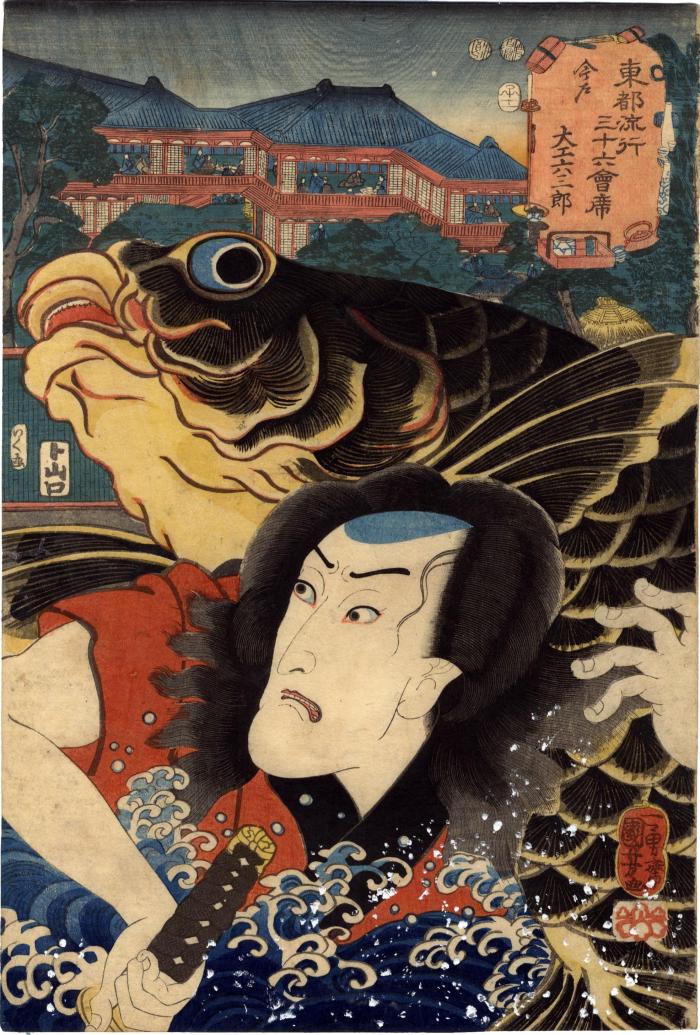Utagawa Kuniyoshi (歌川国芳)
(artist 11/15/1797 – 03/05/1861)
Utagawa Yoshiiku (歌川芳幾 - 1833-1904)
(artist )
Imado (今戸): Onoe Kikugorō III as the carpenter Rokusaburō (大工六三郎), from the series Thirty-six Fashionable Restaurants of the Eastern Capital (Tōto ryūkō sanjūroku kaiseki - 東都流行三十六会席)
11/1852
9.75 in x 14.5 in (Overall dimensions) Japanese woodblock print
Signed: Ichiyūsai Kuniyoshi ga
一勇斎国芳画
Artist's seal: kiri
Also signed: Iku ga (いく画)
Publisher: Yamaguchiya Tōbei
(Marks 591 - seal not listed)
Date: 11/1852
Censors: Mera and Watanabe
Museum of Fine Arts, Boston - without gofun
Waseda University - with a smattering of gofun toward the bottom
Lyon Collection - similar Shigeharu print on a related theme
Lyon Collection - similar Kunisada diptych on a related theme
Nationaal Museum van Wereldculturen (Rijksmuseum Volkenkunde, Leiden) via Ritsumeikan University - with no gofun
Hankyu Culture Foundation - with no gofun The foreground is by Kuniyoshi. The background is by Yoshiiku. The title cartouche is surrounded with the items used in a restaurant. The British Museum shows 8 different prints from this series online, but not this one.
This print was used for one of the the covers of an edition of Timothy Clark's book Kuniyoshi: From the Arthur R. Miller Collection. (The edition I own does not show this print either on the cover or within the text.)
****
"Although the name of the actor is not given on this print - probably due to the lingering influence of the Tenpō reforms of the early 1840s - it is nevertheless identifiable as a posthumous half-length portrait of the actor Onoe Kikugorō III (1784-1849) in the role of the carpenter Rokusaburō. Originally called Onoe Matsusuke II, this actor assumed the name Kikugorō III in 1815 and was one of kabuki's most versatile performers, receiving the accolade of kaner yakusha ('all-around actor). Kunisada executed an earlier portrait of him in the same role in the series Ōatari kyōgen no uchi (Great stage hits).
Rokusaburō is the main character in the kabuki play Mijikayo ukina no chirashigaki. The scene depicted in this print is called 'catching the carp' (koi tsukami) a type of mizu kyōgen - a play in which water was actually used on stage - belonging to the broader category of summer plays (natsu kyōgen. 'Catching the carp' was a favorite event: water from a large tank is utilised when fights with a carp or the appearance of a fish's spirit are staged."
Illustrated in and quoted from: Heroes and Ghosts: Japanese Prints by Kuniyoshi 1797-1861 by Robert Schaap, Hotei Publishing, 1998, page 171, no. 183.
****
Illustrated:
1) in color in Heroes and Ghosts: Japanese Prints by Kuniyoshi 1797-1861 by Robert Schaap, Hotei Publishing, 1998, page 171, no. 183.
2) in color in Utagawa Kuniyoshi: 342 Color Paintings [sic] of Utagawa Kuniyoshi by Jacek Michalak, Kindle Edition, 2022, unpaginated.
****
Osakaprints.com gave a cogent summary of this scene based on a different play on this same topic: "The play was an adaptation of one of the most notorious double suicide stories (shinjû-mono), this one involving the carpenter Rokusaburô and the courtesan Osono, inspired by an actual event in 1749. (The Osaka citizenry was shocked by yet another death on the same day, when a prostitute was executed for murdering Osono's brother.)
The popular theatrical retelling also involves the theft of a precious scroll painting of a carp (koi). When Rokusaburô tracks down the thieves and wrestles the scroll away from them, the carp comes to life and escapes. Shigeharu's print shows him trying to capture the carp, a scene called koi no tsukamimono ("catching hold of the carp"). The play was performed in the summer, and real water was used on the stage (called mizuiri or "in the water")."
****
This print in the Lyon Collection is carefully splattered with white dots, gofun, in the lower areas where Rokusaburō is splashing around in the water. Only the copy at Waseda University shows this technique. Yet we believe it was done at the time of its production, because of the precise placement of its location.
On the other hand, this copy in the Lyon Collection prominently displays the woodgrain at the top center of this print, whereas the copy in Boston does not. And the woodgrain in the example in the copy in the collection of Waseda University - probably the same as the example in Boston - is printed from different blocks. To confuse matters even more, the copy at the Hankyu Culture Foundation uses the same blocks as the one in the Lyon Collection. The application of the inks in the rooftop of the restaurant alone indicate that there was a completely different set of editions of this impressive print.
Yamaguchiya Tōbei (山口屋藤兵衛) (publisher)
actor prints (yakusha-e - 役者絵) (genre)
Onoe Kikugorō III (三代目尾上菊五郎: 11/1815-3/1848) (actor)
